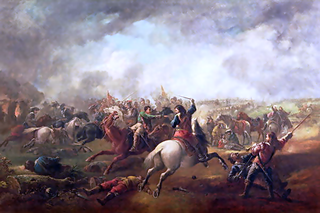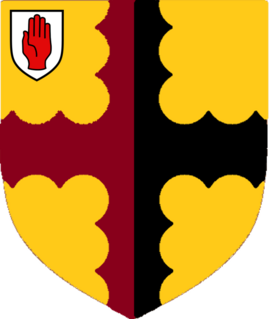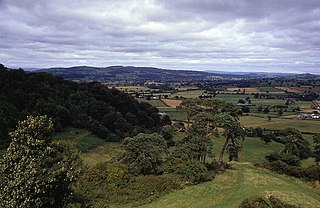See also
- Treaty of Neutrality (Yorkshire) signed on 29 September 1642 by Lord Fairfax for Parliament and Henry Bellasis for the Royalists
- Clubmen for attempts by men in other counties to remain neutral during the war.
The Bunbury Agreement of December 23, 1642 was a declaration of neutrality drawn up by some prominent gentlemen of the county of Cheshire shortly after the outbreak of the First English Civil War. Like similar attempts in Lancashire and other counties, it was ignored by both Parliament and Charles I, since the strategic importance of Cheshire and the city port of Chester meant national interests overruled local ones.
The outbreak of the First English Civil War in August 1642 led to a summer of skirmishes in Cheshire as both sides attempted to gain control of the region. Henry Mainwaring and Mr. Marbury of Marbury Hall for Parliament and Lord Kilmorey and Sir Orlando Bridgeman, son of the Bishop of Chester, for the Royalists agreed to meet on December 23 at Bunbury. [1] They agreed that all fighting in Cheshire would end. All prisoners would be released, property taken during the conflict returned to its owners and any losses compensated by a levy on both sides. Fortifications were to be removed at Chester, Nantwich, Stockport, Knutsford and Northwich and their combined forces would escort any external forces out of the county. Both parties agreed that there were to be no further troop movements through Cheshire, and that they would not to raise any more troops locally. Everything depending on the agreement of their national commanders, whom they would urge to settle their differences peacefully.
Given the national strategic importance of Cheshire, it proved impossible for the local gentry to agree a local neutrality pact that their national commanders would agree to. Geographically Cheshire lies between the Pennines and the north Welsh foothills and so whoever controlled Cheshire controlled the western route to north west England and Scotland as well as an important route into north Wales. For Parliament the control of Cheshire would mean separating the King's northern supporters from the King and his army at Oxford. It could also stop the King bringing in reinforcements from his Irish army through the port of Chester. During the summer the King's supporters had not been idle and Chester's defences had been strengthened with the Commissioners of Array arranging to man the defences. In addition the city's corporation raised an additional 300 men to assist them, that were paid for by a monthly assessment (local tax) on all inhabitants. These preparations continued in December when the corporation raised more money through another assessment for additional weapons and fortifications. [2] [3]
Sir William Brereton and Dunham Massey, the leading Parliamentarians in Cheshire were in London and did not agree with the Agreement. On 9 January 1643 (New Style) Brereton was commissioned by Parliament to take control of the Parliamentary forces in Cheshire and Massey was ordered to take command of the Cheshire Militia. These actions effectively killed the Agreement.
On 19 January, the King announced that he was sending Sir Thomas Aston as a Major-General to Cheshire and Lancashire. Aston's orders were simply stated by Prince Rupert; he was to take his regiment to Shropshire, raise forces of horse and foot there, and then defend Cheshire against the Parliamentary force that was heading to the county from London under the leadership of Sir William Brereton. He was also to seize arms and ammunition for the King's use and "put into execution the laws and customs martial upon all offenders.....for the better preventing of disorders, plunderings and outrages which are often committed by soldiers." He was told to achieve this and return to the main army by 15 March unless he received orders to the contrary. The Cheshire Commissioners of Array were also given explicit orders as to what they should do to help Aston. The King explained to them that as the Parliamentarians had rejected the Bunbury Agreement and were sending a force to Cheshire, he was sending Aston and his regiment of horse to protect the county.
After some skirmishes and maneuvering for position, these two opposing forces would fight a pitched battle, the First Battle of Middlewich, on 13 March 1643. [4]
The Battle of Nantwich was fought on 25 January 1644 in Cheshire during the First English Civil War. In the battle, Sir Thomas Fairfax in command of a Parliamentarian relief force defeated Lord Byron and the Royalists.

Sir William Brereton, 1st Baronet, (1604–1661), was an English Puritan who owned extensive estates in Cheshire, and Member of Parliament for Cheshire county at various times between 1628 and 1653. During the First English Civil War, he was commander of Parliamentarian forces in the North Midlands.

The First English Civil War was fought in England and Wales from approximately August 1642 to June 1646. One of the conflicts known collectively as the 1638 to 1651 Wars of the Three Kingdoms, others include the Bishops' Wars, the Irish Confederate Wars, the Second English Civil War, the Anglo-Scottish war (1650–1652) and the Cromwellian conquest of Ireland. Modern estimates suggest that 15% to 20% of all adult males in England and Wales served in the military at some point between 1638 to 1651, while around 4% of the total population died from war-related causes, compared to 2.23% in World War I. These figures demonstrate the impact of the conflict on society in general and the bitterness it engendered.

The Battle of Hopton Heath was a battle of the First English Civil War, fought on Sunday 19 March 1643 between Parliamentarian forces led by Sir John Gell, 1st Baronet and Sir William Brereton and a Royalist force under Spencer Compton, 2nd Earl of Northampton.
The First Battle of Middlewich took place on 13 March 1643, during the First English Civil War, and was fought between the Parliamentarians, under Sir William Brereton, and the Royalist supporters of King Charles I of England, under Sir Thomas Aston.
The Second Battle of Middlewich was a battle of the First English Civil War that took place on 26 December 1643 in Cheshire County. In the battle, Lord Byron and the Royalists defeated a Parliamentarian army commanded by Sir William Brereton.

Sir Thomas Aston, 1st Baronet was an English politician who sat in the House of Commons in 1640. He fought for the Royalist cause in the English Civil War.

Sir Henry Brooke, 1st Baronet was an English soldier and politician.
Sir John Hotham the younger, known as Captain Hotham, was an English Member of Parliament and military commander who fought for the Parliamentarians during the First English Civil War. He was executed for treason in 1645.

Robert Venables, was an English soldier from Cheshire, who fought for Parliament in the 1638 to 1651 Wars of the Three Kingdoms, and captured Jamaica in 1655.
The Treaty of Neutrality signed on 29 September 1642 by Lord Fairfax for Parliament and Henry Bellasis for the Royalists, the two Knights of the Shire who represented Yorkshire in Parliament, with the support and agreement of other gentlemen of the county, in the hope of avoiding civil war in Yorkshire. The treaty was disowned by Parliament on 4 October 1642.

The Battle of Burton Bridge was fought between Royalist and Parliamentarian forces at Burton upon Trent on 4 July 1643 during the First English Civil War. By the time of the battle, the town, which had at various times been held by both sides, was garrisoned by a Parliamentarian unit under the command of Captain Thomas Sanders and the town's military governor, Colonel Richard Houghton. The key river crossing at Burton was desired by Queen Henrietta Maria, who was proceeding southwards from Yorkshire with a convoy of supplies destined for King Charles I at Oxford. The Royalists, led by Colonel Thomas Tyldesley, launched a cavalry charge across the bridge which succeeded in defeating the Parliamentarians and capturing most of their officers, including Sanders and Houghton. The Queen's convoy proceeded on its way south to Oxford, with Tyldesley receiving a knighthood and a promotion in recognition of his victory. Burton changed hands several more times during the course of the war, before finally coming under Parliamentarian control in 1646.

Sir Vincent Corbet, 1st Baronet was an English lawyer and politician who sat for Shropshire in the House of Commons in the Short Parliament of 1640. He fought on the Royalist side in the English Civil War.

Robert Tatton was the High Sheriff of Chester between 1645 and 1646. A supporter of King Charles I in the English Civil War, Robert is perhaps best known for the ultimately unsuccessful defence of his family home, Wythenshawe Hall, during its three-month siege by a Parliamentary force in the winter of 1643/44.

Sir Gilbert Hoghton, 2nd Baronet was an English politician who sat in the House of Commons variously between 1614 and 1640. He was a Royalist leader during the English Civil War.
This is a timeline for the English Civil War in Shropshire.

The siege of Chester occurred over a 16-month period between September 1644 and February 1646 during the First English Civil War. In the engagement, Sir William Brereton and the Parliamentarians were ultimately successful in taking possession of the city and Royalist garrison commanded by Lord Byron.

The Battle of Montgomery took place during the First English Civil War of 1642–1646. On 17 September 1644, a Parliamentarian force commanded by Sir John Meldrum advanced to engage a Royalist army led by Lord Byron which was besieging Montgomery Castle in mid Wales. The battle was fought the next day. After the Royalists gained an initial advantage, the Parliamentarians counter-attacked and destroyed Byron's army.
The Battle of Leeds took place during the First English Civil War on 23 January 1643, when a Parliamentarian force attacked the Royalist garrison of Leeds, Yorkshire. The attack was partly dictated by the need to maintain local support for the Parliamentarian cause; the Earl of Newcastle had recently shifted the balance of power in Yorkshire in the Royalists' favour with the addition of his 8,000-strong army, and sent one of his commanders, Sir William Savile to capture Leeds. The West Riding of Yorkshire relied on the cloth trade, and Ferdinando, Lord Fairfax sent his son, Sir Thomas Fairfax to bolster the defences of nearby Bradford, before agreeing to his request to attack Leeds.
Colonel Sir Gilbert Gerard was a Royalist officer during the English Civil War.